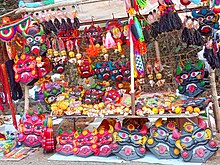A drishti bommai (Tamil), drishti gombe (Kannada) or drishti bomma (Telugu) is a talisman represented as a doll, predominantly found in South India. Regarded to possess apotropaic properties, these dolls are prominently hung at construction sites, houses, residential buildings, and trucks,[1][2] intended to ward off evil. They are regarded to be benevolent asuras, featured as intimidating in appearance to frighten malicious forces.[3] Similar to the Gorgoneion heads of ancient Greece, the decorative wide-eyed, often red, yellow, or green[4] moustached masks and can be seen in the Indian states of Tamil Nadu, Karnataka, Telangana, and Andhra Pradesh, and the union territory of Puducherry.[5]

References edit
- ^ "Evil eye doll (Drishti Bommai) vendors at Tiruchirappalli district" (PDF). International Journal of Applied Research. 2 (5): 666–668. 2016. Retrieved 21 July 2022.
- ^ "Rational thinking affected sales, say 'Drishti Bommai' vendors". Dtnext.in. 21 January 2019. Archived from the original on March 11, 2022.
- ^ U, Chandrashekar B. Astronomy In Ancient Indian Belief Systems. Chandrashekar B U. p. 68.
- ^ Singh, S. Harpal (22 November 2009). "Warding off the evil eye". The Hindu.
- ^ "Drishti Gombe Making - Bengaluru, Karnataka" (PDF). Dsource.in. Retrieved 21 July 2022.